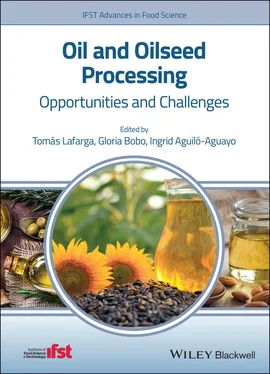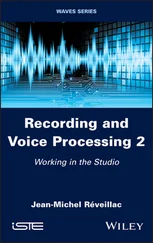10 Chapter 11Table 11.1 Main fatty acid composition of some vegetable oils in percentage (...Table 11.2 Main phytosterols and tocopherols identified in some vegetable oil...
1 Chapter 1 Figure 1.1 World production of palm fruit, olives, and most economically imp... Figure 1.2 Area harvested and production of palm, rapeseed, soybean, and sun... Figure 1.3 Palm oil: Production and trade. Abbreviation: PNG, Papua New Guin... Figure 1.4 Rapeseed oil: Production and trade. Abbreviations: CR, Czech Repu... Figure 1.5 Soybean oil: Production and trade. Abbreviation: US, United State... Figure 1.6 Sunflower seed oil: Production and trade.
2 Chapter 3 Figure 3.1 Scheme modified from Lafarga et al. (2019a) representing the down... Figure 3.2 Processes and uses of microalgae to obtain biofuels and high‐valu...Figure 3.3 Scheme from Nowak et al. (2016) representing the food entries inc...Figure 3.4 Bar chart from Rumpold and Schlüter (2013) representing the avera...Figure 3.5 Scheme from Garcia‐Vaquero and Hayes (2016) summarizing the main ...
3 Chapter 4Figure 4.1 Structures of (a) oleic acid and (b) linoleic acid, the major mon...Figure 4.2 Structures of (a) β‐sitosterol – one of the most prominent sterol...Figure 4.3 Structure of tocols: (a) Tocopherols; (b) Tocotrienols.Figure 4.4 Classification of lipids in nuts and cereals.
4 Chapter 5Figure 5.1 1H NMR spectra of a salmon oil stored at 40 °C (in closed 50 ml p...Figure 5.2 PCA score plot of salmon oil (circles) and other fish oil samples...Figure 5.3 Process of how to develop a machine learning model for regression...Figure 5.4 FT‐MIR spectra of cod liver oil, beef fat, chicken fat, and mutto...Figure 5.5 Example structure of a fully‐connected multilayer feed‐forward AN...Figure 5.6 Exemplary spectra of a crude cod liver oil, a refined sunflower o...
5 Chapter 7Figure 7.1 Oleic acid and naturally occurring C 18hydroxy and epoxy fatty ac...Figure 7.2 Naturally occurring C 18di‐ and tri‐unsaturated fatty acids.Figure 7.3 Modification of double bonds in fatty acyl groups to produce func...Figure 7.4 Diels‐Alder reaction between calendic acid methyl ester (18:3‐8t,...Figure 7.5 Acyclic triene metathesis (ATMET) of triolein, using methyl acryl...Figure 7.6 Ring‐opening metathesis polymerization (ROMP) of Dilulin™ and dis...Figure 7.7 Formation of fatty acid methyl esters (FAME; i.e. biodiesel) in t...Figure 7.8 Conversion of monocaprylate into methyl caprylate and 1,3‐dioxola...Figure 7.9 Conversion of triolein and tristearin into hydrocarbons via catal...Figure 7.10 Biobased surfactant synthesis within the oleochemical refinery....Figure 7.11 Biobased surfactants prepared from seed oils.
6 Chapter 8Figure 8.1 Evolution of total RASFF notifications between 2012 and 2018.Figure 8.2 (a) Extracted ion chromatogram of a lampante olive oil sample con...Figure 8.3 Molecules of 3‐MCPD, 2‐MCPD, their esters, and glycidyl ester.Figure 8.4 Examples of structures of MOSH.Figure 8.5 Examples of structures of MOAH.
7 Chapter 9Figure 9.1 By‐products generated during oilseed processing and their potenti...
8 Chapter 12Figure 12.1 Lypoxygenase pathway for the formation of major volatile compoun...Figure 12.2 Variation in volatile profile compounds of palm oil with heating...
1 Cover Page
2 Oil and Oilseed Processing
3 Title Page Oil and Oilseed Processing Opportunities and Challenges Edited by Tomás Lafarga University of Almería, Almería Spain Gloria Bobo IRTA, Lleida Spain Ingrid Aguiló‐Aguayo IRTA, Lleida Spain
4 Copyright
5 Preface
6 List of Contributors
7 Table of Contents
8 Begin Reading
9 Index
10 WILEY END USER LICENSE AGREEMENT
1 ii
2 iii
3 iv
4 xi
5 xiii
6 xiv
7 xv
8 1
9 2
10 3
11 4
12 5
13 6
14 7
15 8
16 9
17 10
18 11
19 12
20 13
21 14
22 15
23 16
24 17
25 18
26 19
27 20
28 21
29 23
30 24
31 25
32 26
33 27
34 28
35 29
36 30
37 31
38 32
39 33
40 34
41 35
42 36
43 37
44 38
45 39
46 40
47 41
48 42
49 43
50 44
51 45
52 46
53 47
54 48
55 49
56 50
57 51
58 52
59 53
60 54
61 55
62 56
63 57
64 58
65 59
66 60
67 61
68 62
69 63
70 64
71 65
72 66
73 67
74 68
75 69
76 70
77 71
78 72
79 73
80 74
81 75
82 76
83 77
84 78
85 79
86 81
87 82
88 83
89 84
90 85
91 86
92 87
93 88
94 89
95 90
96 91
97 92
98 93
99 94
100 95
101 96
102 97
103 98
104 99
105 100
106 101
107 103
108 104
109 105
110 106
111 107
112 108
113 109
114 110
115 111
116 112
117 113
118 114
119 115
120 116
121 117
122 119
123 120
124 121
125 122
126 123
127 124
128 125
129 126
130 127
131 128
132 129
133 130
134 131
135 132
136 133
137 134
138 135
139 136
140 137
141 138
142 139
143 140
144 141
145 142
146 143
147 144
148 145
149 146
150 147
151 148
152 149
153 150
154 151
155 152
156 153
157 154
158 155
159 156
160 157
161 158
162 159
163 160
164 161
165 162
166 163
167 164
168 165
169 166
170 167
171 168
172 169
173 170
174 171
175 172
176 173
177 174
178 175
179 176
180 177
181 178
182 179
183 180
184 181
185 183
186 184
187 185
188 186
189 187
190 188
191 189
192 190
193 191
194 192
195 193
196 194
197 195
198 196
199 197
200 198
201 199
202 200
203 201
204 203
205 204
206 205
207 206
208 207
209 208
210 209
211 210
212 211
213 212
214 213
215 214
216 215
217 216
218 217
219 219
220 220
221 221
222 222
223 223
224 224
225 225
226 226
227 227
228 228
229 229
230 230
231 231
232 232
233 233
234 234
235 235
236 236
237 237
238 238
239 239
240 240
241 241
242 242
243 243
244 245
245 246
246 247
247 248
248 249
249 250
250 251
251 252
252 253
253 254
254 255
255 256
256 257
257 258
258 259
259 260
260 261
261 262
262 263
263 264
264 265
265 266
266 267
267 268
268 269
269 270
270 271
271 272
272 273
273 274
274 275
275 276
276 277
277 278
278 279
279 280
280 281
281 282
282 283
283 284
284 285
About the IFST Advances in Food Science Book Series
The Institute of Food Science and Technology (IFST) is the leading qualifying body for food professionals in Europe and the only professional organization in the UK concerned with all aspects of food science and technology. Its qualifications are internationally recognized as a sign of proficiency and integrity in the industry. Competence, integrity, and serving the public benefit lie at the heart of the IFST philosophy. IFST values the many elements that contribute to the efficient and responsible supply, manufacture, and distribution of safe, wholesome, nutritious, and affordable foods, with due regard for the environment, animal welfare, and the rights of consumers. IFST Advances in Food Science is a series of books dedicated to the most important and popular topics in food science and technology, highlighting major developments across all sectors of the global food industry. Each volume is a detailed and in‐depth edited work, featuring contributions by recognized international experts, and which focuses on new developments in the field. Taken together, the series forms a comprehensive library of the latest food science research and practice, and provides valuable insights into the food processing techniques that are essential to the understanding and development of this rapidly evolving industry. The IFST Advances series is edited by Dr. Brijesh Tiwari, who is Senior Research Officer at Teagasc Food Research Centre in Ireland.
Читать дальше












